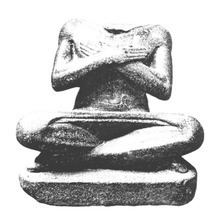Children Mentuhotep I Great grandchildren Intef III, Iah | Mother Iku(i) Grandchildren Intef I, Intef II | |
 | ||
Reign 22nd century BC (Eleventh Dynasty of Egypt) Burial uncertain, possibly a tomb at Dra' Abu el-Naga' Similar Mentuhotep I, Intef I, Intef II | ||
Intef, whose name is commonly accompanied by epithets such as the Elder, the Great (= Intef-Aa) or born of Iku, was a Theban nomarch during the First Intermediate Period c. 2150 BC and later considered a founding figure of the 11th Dynasty, which eventually reunified Egypt.
Contents
Reign
Intef the Elder was not a pharaoh but rather the nomarch of Thebes c. 2140 BC. As such he would have nominally served either a king of the 8th Dynasty or one of the Herakleopolitan kings of 9th or 10th Dynasty. Intef the Elder would have controlled the territory from Thebes to Aswan to the south and not farther north than Koptos, which was then controlled by another dynasty of nomarchs. Intef is believed to be the father of his successor on the Theban throne, Mentuhotep I.
Attestations
Intef the Elder was seemingly perceived as a founding figure of the 11th Dynasty after his death. For example, his name figures in the chapel of royal ancestors erected at Karnak by Thutmose III over 600 years after Intef's death. In the chapel, Intef is given the titles of "Count and Hereditary Prince". Intef the Elder is probably to be identified with the Intef-Aa ("the Great") son of Iku, to whom Senusret I dedicated a seated statue representing Intef as a scribe:
Made by the king of Upper and Lower Egypt Kheperkare as his monument for his father prince Intef the Elder [...] born of Iku
Intef the Elder was also the object of private cults, as shown by the stele of Maat, a minor official of Mentuhotep II, which is now in New York. On his stele Maat asks that prayers be told for "Intef the Elder the son of Iku". Intef may also be mentioned on a stele from Dendera, the two pieces of which are now in Strasbourg (inv. no. 345) and in Florence (inv. no. 7595), and which further gives him the title of "Great prince of the southland". The attribution of this stele to Intef the Elder is debated.
Given the importance of Intef the Elder in the eyes of his successors, Alan Gardiner proposed that Intef the Elder was mentioned on the Turin canon in column 5 line 12. This remains conjectural however as this section of the papyrus is completely missing.
Tomb
Auguste Mariette unearthed a stele of the "hereditary prince Intefi" at Dra' Abu el-Naga' on the west bank of Thebes and now in the Egyptian Museum CG 20009. The stele gives the titles of Intef and shows that he served an unnamed pharaoh:
An offering which the king gives to Anubis, who is upon his mountain, who is in the place of embalming, Lord of the holy place, that he may give to the hereditary prince, count, great lord of the Theban nome, satisfying the king as keeper of the gateway of the south, great pillar of him who makes his two lands to live, the chief prophet devoted to the great god Intefi.
Jürgen von Beckerath believes this stele was Intef's funerary stele, originally placed in a chapel near his tomb.
